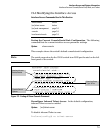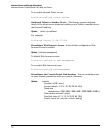
6-21
Switch Memory and Configuration
Using Primary and Secondary Flash Image Options
Operating Notes
Default Boot Source. The switch reboots from primary flash by default
unless you specify the secondary flash.
Boot Attempts from an Empty Flash Location. In this case, the switch
aborts the attempt and displays
Image does not exist
Operation aborted.
Interaction of Primary and Secondary Flash Images with the Current
Configuration. The switch has one startup-config file (page 6-2), which it
always uses for reboots, regardless of whether the reboot is from primary or
secondary flash. Also, for rebooting purposes, it is not necessary for the
software image and the startup-config file to support identical software fea-
tures. For example, suppose you have just downloaded a software upgrade
that includes new features that are not supported in the software you used to
create the current startup-config file. In this case, the software simply assigns
factory-default values to the parameters controlling the new features. Simi-
larly, If you create a startup-config file while using a version “Y” of the switch
software, and then reboot the switch with an earlier software version “X” that
does not include all of the features found in “Y”, the software simply ignores
the parameters for any features that it does not support.
Scheduled Reload. If no parameters are entered after the reload command,
an immediate reboot is executed. The reload at and reload after command
information is not saved across reboots. If the switch is rebooted before a
scheduled reload command is executed, the command is effectively cancelled.
When entering a reload at or reload after command, a prompt will appear to
confirm the command before it can be processed by the switch. For the reload
at command, if mm/dd/yy are left blank, the current day is assumed.
The scheduled reload feature removes the requirement to physically reboot
the switch at inconvenient times (for example, at 1:00 in the morning). Instead,
a reload at 1:00 mm/dd command can be executed (where mm/dd is the date
the switch is scheduled to reboot).


















